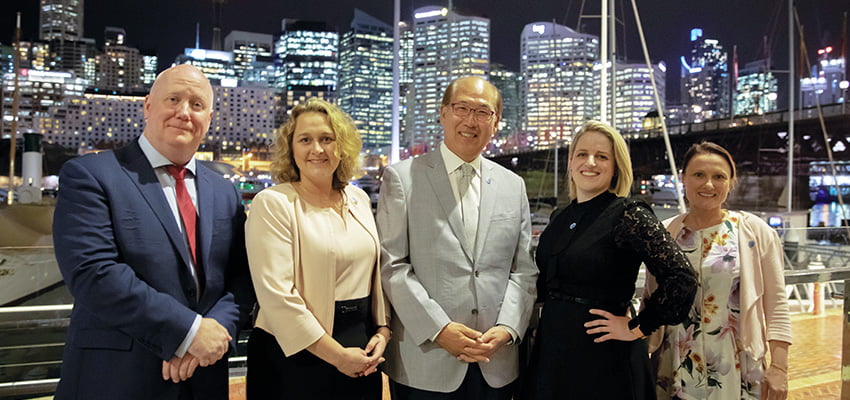WHEN was the last time you visited the United Nations website on Observances of International Days? I suggest you take a look – there are quite a few amazing days to celebrate. In September alone there are 14 different international days listed. The International Day of Peace was celebrated on 21 September, the 26th promoted the Total Elimination of Nuclear Weapons and 28 September encouraged Universal Access to Information. September seemed to truly be a month of peace, empowerment and new beginnings.
It seemed fitting, then, that the last Thursday in September was World Maritime Day. Without shipping, without a healthy maritime environment, life would be very different. Although WMD officially fell on 26 September this year, WMD is often celebrated throughout the year. As you likely already know, the theme of WMD was “Empowering Women in the Maritime Community”.
The celebrations began on 1 January and will continue throughout the year. The year 2019 is truly a chance to celebrate the amazing diversity in the maritime industry, and empower women in maritime.
It’s all about empowerment
All over the world we are seeing a focus on the benefit of diversity, including gender diversity, in the maritime environment. Over the course of this year you have had a chance to learn about the astonishingly low percentage of women in the maritime industry, and also to meet some of the incredible women who are making waves.
On 29 July, the Australian Maritime Safety Authority welcomed the IMO secretary-general Kitack Lim to Australia, providing an opportunity to showcase the efforts at the international, regional and local level to address the significant gender imbalance in our industry.
The evening event included a series of keynote presentations from IMO, AMSA and inspirational women in the industry. With an opportunity for informal discussions, the evening event was firmly focused on empowering women in maritime.
In opening the event, AMSA CEO Mick Kinley highlighted many issues in supporting diversity in the industry, stressing that it isn’t just right for social justice, it is good for business outcomes.
Records show that 57 AMSA STCW certificates have been issued to female masters, with 20 certificates active. Looking at the lower levels, there were only 14 chief mate certificates and 22 deck. This highlights the need to do more to support those in the system, and also the need to address the decline in seafarers and skill set by encouraging women, and men, into the industry.
Within AMSA itself, Mr. Kinley noted that there had been a 39% increase in female employees since 2014 throughout all areas of AMSA, with women now comprising 22% of senior managers.
The international level
Mr Lim arrived in Australia after a tour of the South Pacific states, where he met with the Pacific Women in Maritime organisations. While highlighting the challenges experienced by the region, he conveyed his appreciation to Australia for the strong support they provide in the region, and in the global maritime community.
A particularly memorable comment from his speech noted that the work of the IMO continues to focus on “the wellbeing of the planet and all human kind”. With the rapid developments in the industry, including the radical new trends of digitisation, he highlighted the need to adopt solutions that are effective within the maritime industry, taking the human element into consideration.
The human element includes the support of diversity – and the empowerment of women in maritime. Mr Lim expressed amazement at the overwhelming support for the social media campaign around the WMD theme, and the initiatives that are being taken by the member states of the IMO. This includes preparing an IMO resolution to continue the promotion of women in the maritime industry, and the development of a network to co-ordinate the activity, after 2019 when the WMD theme is gone – but not forgotten.
If you can’t see it, you can’t be it
At the AMSA event, keynote presentations were made by influential women in the maritime industry including Teresa Lloyd, Alison Cusack and Jeanine Drummond.
The overwhelming feeling from these presentations was “if you can’t see it, you can’t be it”. Representing different aspects of the industry, these three women all highlighted concerns over the slow rate of change, with many women in the industry today continuing to experience the same issues, and tell the same stories, as those experienced decades ago.
Women in a male-dominated environment often feel pressured to fit in, to adapt – yet it is their diverse viewpoints that are critical to support a vibrant maritime industry.
So how can we work to see actual gains? To achieve diversity and empowerment there is a need for strong support at all levels, afloat and ashore. Stressing the positive, yes, but recognising the negative; putting in place opportunities for women within the industry and realising that there will be imperfect progress, but progress none the less. Small steps, such as calling out inappropriate behaviour; recognising and encouraging efforts; thinking consciously about each small effort that we can take, every day, towards gender equality.
This also includes increasing the visibility of women in maritime, through initiatives such as the Nautical Institute South East Australia Branch #womeninmaritime 365 day challenge. With visibility comes responsibility, the need to provide mentoring and networking opportunities, leveraging on the work being done in so many discrete areas of the industry and providing a steady, co-ordinated approach to improving diversity.
In the words of Ms Drummond, “We need to see a future when there is no longer a female seafarer, there are just seafarers”.
Our challenge is how quickly we can achieve that?
* Jillian Carson-Jackson is the senior vice-president of the Nautical Institute
This article appeared in the September 2019 edition of DCN Magazine

